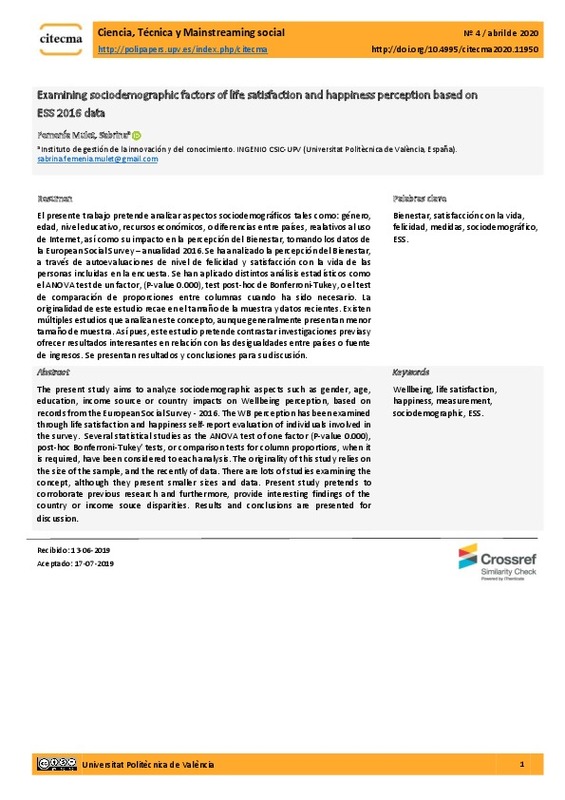Abdallah, S., & Mahony, S. (2012). WP2-Task 2: Stock-taking of Subjective Well. New Economics Foundation.
Afradi, N., Asghari, B., & Manie, F. M. (2017). "Relation ship between dependence on modern communication tools and psychological well-being in students". In Journal of Research & Health, 7(1), 637-646. https://doi.org/10.18869/acadpub.jrh.7.1.637
Argyle, M. (2001). The psicology of hapiness.(2nd ed.). New York, NY, US: Routledge
[+]
Abdallah, S., & Mahony, S. (2012). WP2-Task 2: Stock-taking of Subjective Well. New Economics Foundation.
Afradi, N., Asghari, B., & Manie, F. M. (2017). "Relation ship between dependence on modern communication tools and psychological well-being in students". In Journal of Research & Health, 7(1), 637-646. https://doi.org/10.18869/acadpub.jrh.7.1.637
Argyle, M. (2001). The psicology of hapiness.(2nd ed.). New York, NY, US: Routledge
Arrosa, M. L., & Gandelman, N. (2016). "Happiness decomposition: Female optimism". In Journal of Happiness Studies, 17(2), 731-756. https://doi.org/10.1007/s10902-015-9618-8
Bartolini, S., & Bilancini, E. (2010). "If not only GDP, what else? Using relational goods to predict the trends of subjective well-being". In International Review of Economics, 57(2), 199-213. https://doi.org/10.1007/s12232-010-0098-1
Diener, E., Lucas, R. E., & Oishi, S. (2002). "Subjective well-being" in Snyder, López Handbook of positive psychology,16(2), 63-73.
Diener, E., Suh, E. M., Lucas, R. E., & Smith, H. L. (1999). "Subjective well-being: Three decades of progress". Psychological bulletin, 125(2), 276. https://doi.org/10.1037/0033-2909.125.2.276
Djankov, S., Nikolova, E., & Zilinsky, J. (2016). "The happiness gap in Eastern Europe". Journal of Comparative Economics, 44(1), 108-124. https://doi.org/10.1016/j.jce.2015.10.006
Easterlin, R. A. (1974). "Does economic growth improve the human lot? Some empirical evidence". In Nations and households in economic growth (pp. 89- 125). https://doi.org/10.1016/B978-0-12-205050-3.50008-7
Easterlin, R. A. (2010). "Happiness, growth and the life cycle". Europe Journal of Psychology, 7(2), 395-398.
Easterlin, R. A. (2013). "Happiness, growth, and public policy". Economic Inquiry, 51(1), 1-15. https://doi.org/10.1111/j.1465-7295.2012.00505.x
Fortin, N. I. C. O. L. E., Helliwell, J. F., & Wang, S. H. U. N. (2015). "How does subjective well-being vary around the world by gender and age". World happiness report, 42-75.
Frey, B. S. (2018). "Happiness Can Be Measured". In Economics of Happiness(pp. 5-11). Springer, Cham. https://doi.org/10.1007/978-3-319-75807-7_2
Graham, C., & Pozuelo, J. R. (2017). "Happiness, stress, and age: How the U curve varies across people and places". Journal of Population Economics, 30(1), 225-264. https://doi.org/10.1007/s00148-016-0611-2
Huppert, F. A., & So, T. (2009, July). "What percentage of people in Europe are flourishing and what characterises them". In IX ISQOLS Conference.
Judge, T. A., & Bono, J. E. (2001). "Relationship of core self-evaluations traits-self-esteem, generalized self-efficacy, locus of control, and emotional stability-with job satisfaction and job performance: A meta-analysis". Journal of applied Psychology, 86(1), 80. https://doi.org/10.1037/0021-9010.86.1.80
Judge, T. A., Thoresen, C. J., Bono,J. E., & Patton, G. K. (2001).The job satisfaction-job performance relationship: A qualitative and quantitative review. https://doi.org/10.1037/0033-2909.127.3.376
Layard, R. (2011). Happiness: Lessons from a new science. Penguin UK.
Lyubomirsky S, King L, Diener E (2005). "The benefits of frequent positive affect: does happiness lead to success?"Psychol Bull2005;131(6):803-855. https://doi.org/10.1037/0033-2909.131.6.803
Nowland, R., Necka, E. A., & Cacioppo, J. T.(2018). "Loneliness and social internet use: pathways to reconnection in a digital world? Perspectives"ion Psychological Science, 13(1), 70-87. https://doi.org/10.1177/1745691617713052
OECD (2016). Education at Glance 2016
OECD (2018). Education at Glance 2018
Pavot, W., & Diener, E. (1993). "The affective and cognitive context of self-reported measures of subjective well-being". Social Indicators Research, 28(1), 1-20. https://doi.org/10.1007/BF01086714
Pavot, W., & Diener, E. (2009). "Review of the satisfaction with life scale". In Assessing well-being(pp. 101-117). Springer, Dordrecht. https://doi.org/10.1007/978-90-481-2354-4_5
Seligman, M. E. (2004). Authentic happiness: Using the new positive psychology to realize your potential for lasting fulfillment. Simon and Schuster.
Seligman, M. E. P. (2002). Authentic Happiness. New York: Free Press.Seligman, Martin (2011). Flourish. New York: Free Press. pp.16-20. ISBN9781439190760.
Stanton, C. (2008). The Central Limit Theorem: Java Probability Applets. Accessed at http://www.math.csusb.edu/faculty/stanton/probstat/clt.html, Accessed January 2008.
Stevenson, B., and J. Wolfers (2008)."Economic Growth and Subjective Well-Being: Reassessing the Easterlin Paradox". Brookings Papers on Economic Activity. 1: 1-87 https://doi.org/10.1353/eca.0.0001
Twenge, J. M., Sherman, R. A., & Lyubomirsky, S. (2016). "More happiness for young people and less for mature adults: Time period differences in subjective well-being in the United States, 1972-2014". Social Psychological and Personality Science,7(2), 131-141. https://doi.org/10.1177/1948550615602933
Veenhoven, R. (1991). Questions on happiness: Classical topics, modern answers, blind spots. Subjective well-being: An interdisciplinary perspective, 2, 7-26.
Veenhoven, R. (2013). "The four qualities of life ordering concepts and measures of the good life". In The exploration of happiness(pp. 195-226). SpringerNetherlands. https://doi.org/10.1007/978-94-007-5702-8_11
Vittersø, J., Søholt, Y., Hetland, A., Thoresen, I. A., & Røysamb, E. (2010). "Was Hercules happy? Some answers from a functional model of human well-being". Social Indicators Research, 95(1), 1. https://doi.org/10.1007/s11205-009-9447-4
[-]








